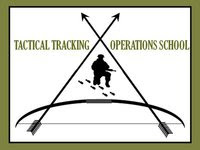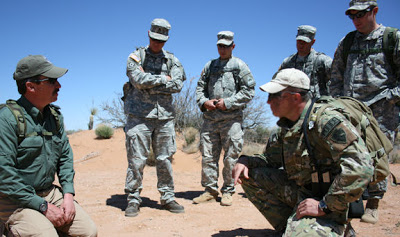Praxis: Tracking on the Battlefield

Old School Scout Trackers on Today's Battlefield by Sergeant First Class Brian Lackey.
(Originally published in Armor Magazine)
When we hear the term "tracker," most of us think back to the days of John Wayne and the 7th Cavalry, conjuring up images of the tracker dismounting his horse, observing the ground, and quickly relaying fascinating information from a single traqck. What most would consider "only in the movies" is very close to reality and is currently employed as a viable skill set in numerous low-intensity conflicts in more relevant and modern times. These skills have been used in Borneo, Malaya, Kenya, Rhodesia, Vietnam, South-West Africa, and currently on a limited scale in Afghanistan and Iraq. Countless reports of successful operations in these areas have been associated or accredited, either directly or indirectly, to intelligence gathered by trackers due to their enhanced observation and awareness skills.
Throughout history, commanders have taken advantage of these skills by gathering vital intelligence, surveillance, and reconnaissance (ISR) to better understand the battlefield. Whether on an active track or simple patrol, tracker-trained soldiers possess a keen sense of detail and quickly recognize what is out of place or missing from the surrounding environment. Early tracking was primarily based on micro-tracking (tracking from print to print), but quickly took on a different role when implemented into the small team concept of combat tracker teams.
With the need for teams to provide their own security, and rapidly track or develop a situation, they moved toward a very aggressive method called "macro-tracking," which, when done correctly, can incorporate the entire team and quickly cover ground, decreasing the time and distance interval of their quarry. This aggressive style of tracking was revolutionized by David Scott-Donelane, formerly of the Rhodesian Selous Scouts, which are considered the most effective unit ever to fight an insurgency. (MBV Note: Also see this link.)
Primitive tracking skills can be employed throughout the operational continuum, but are ideal for counterinsurgency operations. One of the major problems facing U.S. forces during counterinsurgency operations is tracking insurgents after contact is made and they disperse among the population. Only by vigorously pursuing the insurgent, wherever he is located, will it be possible for the military to dominate an area and reduce insurgent activities. To accomplish this effort, soldiers trained in tracking skills must learn to watch for clues or signs of passage inconsistent with normal patterns or an environmental baseline. Forced as they are to move on foot, it impossible for insurgents to avoid leaving traces of passage through an area. It is these traces that the tracker uses to reveal valuable information, such as number of insurgents in a group; direction of travel; time and distance gap between tracker and insurgent; and through deductive reasoning develop, determine, or confirm tactical intelligence.
Trackers are capable of quickly multiplying squadron or battalion capabilities. Battalion scouts often assume the quick reaction force (QRF)/explosive ordnance detachment (EOD) role for their organizations; versatile and flexible units of this nature greatly benefit from this skill set. We have all experienced the frustration felt following an improvised explosive device (IED) attack and more times than not, we end the day reading a storyboard compiled by law enforcement personnel (LEP), EOD, or weapons intelligence team (WIT), outlining the basic information of type and employment method. Integrating trackers with these contracted agencies could deliver intelligence from blast radios to the the insurgent's door step. Effective tactics, techniques, and procedures (TTP) would place LEP/EOD/WIT 100 meters in to investigate the blast radius.

Scout trackers, while providing 300-meter cordon, would complete 360-degree command post operations, identifying all incoming and outgoing traffic, as well as movement direction. The combat tracker team could easily move into an active-track mode, leading to vehicles, villages, houses, caches, and initiating points, virtually doubling its chances of apprehending the enemy. Today's trackers have battlefield enablers, such as unmanned aerial vehicles (UAVs), rotary wing, camera towers, and blimps, which can quickly aid apprehension. During our last deployment, our squadron immediately opened a target information center (TIC) following an IED strike, and we had rotary wing and UAV on site. However, due to a lack of ground information, the rotary wing spent much of its time providing security rather than hunting down the enemy. With a tracker, we could quickly relay vital information, which helped direct air assets to the correct area. We also established a time distance interval, reducing a 360-degree 3-km area to a 30-degree cone, which greatly increased additional blocking or cordon possibilities.
The Tactical Tracking Operations School (TTOS) currently offers a 100-hour mobile training team (MTT) combat tracker course, which is designed to complement any unit's operating procedures. TTOS guides scouts through a well-designed program, moving soldiers from basic to advanced tracking skills, and incorporates training into daily excursions. When I attended the course, we executed nearly 6 hours of field time, putting to use skills we had just learned, to every 2 hours of class time. My team, on several occasions, tracked individuals up to 6kms over the diverse terrain of Fort Irwin, California, maintaining both security and forward movement, which are two key ingredients to apprehension of the quarry/enemy. General operations provide an overwhelming amount of intelligence to today's commanders in every environment. Simplistic in theory and in action, scout trackers belong in our units . . . without question.

 Scout trackers, while providing 300-meter cordon, would complete 360-degree command post operations, identifying all incoming and outgoing traffic, as well as movement direction. The combat tracker team could easily move into an active-track mode, leading to vehicles, villages, houses, caches, and initiating points, virtually doubling its chances of apprehending the enemy. Today's trackers have battlefield enablers, such as unmanned aerial vehicles (UAVs), rotary wing, camera towers, and blimps, which can quickly aid apprehension. During our last deployment, our squadron immediately opened a target information center (TIC) following an IED strike, and we had rotary wing and UAV on site. However, due to a lack of ground information, the rotary wing spent much of its time providing security rather than hunting down the enemy. With a tracker, we could quickly relay vital information, which helped direct air assets to the correct area. We also established a time distance interval, reducing a 360-degree 3-km area to a 30-degree cone, which greatly increased additional blocking or cordon possibilities.The Tactical Tracking Operations School (TTOS) currently offers a 100-hour mobile training team (MTT) combat tracker course, which is designed to complement any unit's operating procedures. TTOS guides scouts through a well-designed program, moving soldiers from basic to advanced tracking skills, and incorporates training into daily excursions. When I attended the course, we executed nearly 6 hours of field time, putting to use skills we had just learned, to every 2 hours of class time. My team, on several occasions, tracked individuals up to 6kms over the diverse terrain of Fort Irwin, California, maintaining both security and forward movement, which are two key ingredients to apprehension of the quarry/enemy. General operations provide an overwhelming amount of intelligence to today's commanders in every environment. Simplistic in theory and in action, scout trackers belong in our units . . . without question.
Scout trackers, while providing 300-meter cordon, would complete 360-degree command post operations, identifying all incoming and outgoing traffic, as well as movement direction. The combat tracker team could easily move into an active-track mode, leading to vehicles, villages, houses, caches, and initiating points, virtually doubling its chances of apprehending the enemy. Today's trackers have battlefield enablers, such as unmanned aerial vehicles (UAVs), rotary wing, camera towers, and blimps, which can quickly aid apprehension. During our last deployment, our squadron immediately opened a target information center (TIC) following an IED strike, and we had rotary wing and UAV on site. However, due to a lack of ground information, the rotary wing spent much of its time providing security rather than hunting down the enemy. With a tracker, we could quickly relay vital information, which helped direct air assets to the correct area. We also established a time distance interval, reducing a 360-degree 3-km area to a 30-degree cone, which greatly increased additional blocking or cordon possibilities.The Tactical Tracking Operations School (TTOS) currently offers a 100-hour mobile training team (MTT) combat tracker course, which is designed to complement any unit's operating procedures. TTOS guides scouts through a well-designed program, moving soldiers from basic to advanced tracking skills, and incorporates training into daily excursions. When I attended the course, we executed nearly 6 hours of field time, putting to use skills we had just learned, to every 2 hours of class time. My team, on several occasions, tracked individuals up to 6kms over the diverse terrain of Fort Irwin, California, maintaining both security and forward movement, which are two key ingredients to apprehension of the quarry/enemy. General operations provide an overwhelming amount of intelligence to today's commanders in every environment. Simplistic in theory and in action, scout trackers belong in our units . . . without question.
2 comments:
Independent war correspondent Michael Yon did a series on the British tracking school in Brunei back in 2009. Much of what was taught there had immediate application in Afghanistan. While open to Americans, few were able to take advantage of it.
The whole series can be found at: http://www.michaelyon-online.com/tracking-afghanistan.htm
Ya' all that man tracin'stuff is groovy; till they lead ya' into there killing zone. If you can see them ( or there tracks) they can see YOU. NEVER BELIVE that your "high speed training" OR your BILLION $ whatzit, makes you better in the bush than the skinny guy who has been trackin' to keep frome starvin' frome birth. You cannot teach city kids more than the basics in 12 weeks, tracking takes a lifetime to learn.
Post a Comment